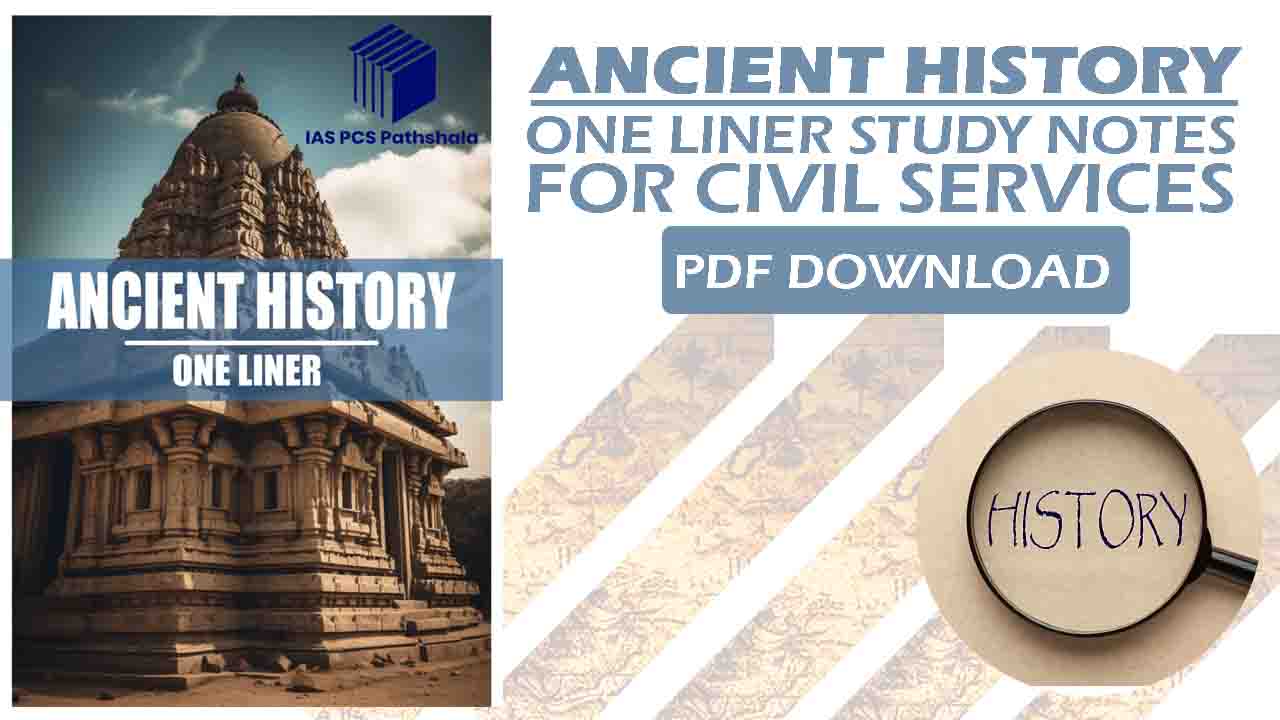Ancient History One-Liner Notes—Hello Friends, In today’s article, we have brought for you Ancient History One-Liner Study Notes, which you can read very easily online and also download.

Ancient History One-Liner Notes
Hello, as you all know, we are constantly adding various useful study materials to our website to help you prepare better for competitive examinations.
Now, in today’s article, we have brought for you Ancient History One Liner Study Notes. This magazine has been published by IAS PCS Pathshala Publication. Let us tell you that IAS PCS Pathshala has very popular publications/institutions that publish various useful study materials from time to time.
One-liner study Notes are the best for quick revision. If you are preparing for Civil Services or any other Government Services, then you know that History is a very important subject, questions related to which are always asked in Competitive Exams.
Because History is divided into 3 parts (Ancient, Medieval & Modern) History, so on this page we have brought notes of Ancient History for you.
About Ancient History One-Liner Study Notes
Ancient Indian History forms a crucial part of the UPSC Civil Services syllabus, especially for the Prelims and GS Paper I of the Mains. Aspirants often struggle with the vastness of the subject, but concise, factual one-liners can make revision fast and effective. This article presents high-yield one-liner notes to help aspirants prepare smartly for the 2025 Civil Services Examination.
Prehistoric Period
- The earliest evidence of human existence in India was found at Paleolithic sites like Bori (Maharashtra).
- Bhimbetka caves in Madhya Pradesh are known for prehistoric rock paintings.
- Neolithic culture in India is best represented by sites like Mehrgarh (Pakistan) and Burzahom (Kashmir).
Indus Valley Civilization (c. 2600–1900 BCE)
- The first discovered site was Harappa (1921) by Daya Ram Sahni.
- The largest site is Mohenjo-Daro (Sindh, Pakistan); in India, it’s Rakhigarhi (Haryana).
- The civilization was urban, with planned cities, drainage systems, and standardized weights.
- The script is undeciphered and was pictographic.
Vedic Period
- Early Vedic period: Rigveda was composed around 1500 BCE on the banks of Saraswati river.
- Society was tribal and pastoral, with emphasis on sacrifices (yajnas).
- Later Vedic period saw the emergence of the mahajanapadas and the varnashrama system.
Mahajanapadas & Religious Movements
- 16 Mahajanapadas are mentioned in Buddhist texts like Anguttara Nikaya.
- Magadha emerged as the most powerful mahajanapada.
- Jainism founded by Mahavira (24th Tirthankara); Buddhism by Gautama Buddha in 6th century BCE.
- First Buddhist council was held at Rajgir under Ajatashatru.
Mauryan Empire (321–185 BCE)
- Founded by Chandragupta Maurya with the help of Chanakya (Kautilya).
- Ashoka the Great was the most prominent Mauryan ruler.
- Ashoka embraced Buddhism after the Kalinga war.
- His inscriptions are the earliest deciphered writings in India, using the Brahmi script.
Post-Mauryan Period
- Indo-Greeks, Shakas, Parthians, and Kushanas invaded NW India.
- Kanishka, a Kushana ruler, patronized Buddhism and convened the 4th Buddhist council in Kashmir.
- Emergence of the Sangam Age in South India with three major Tamil dynasties: Cheras, Cholas, Pandyas.
Gupta Empire (c. 320–550 CE)
- Called the Golden Age of India for its achievements in art, science, and culture.
- Chandragupta I founded the Gupta Empire.
- Samudragupta was called the Napoleon of India by historian V. A. Smith.
- Aryabhata and Kalidasa were luminaries of this era.
Post-Gupta & Early Medieval Period
- Harshavardhana ruled from Thanesar and Kannauj.
- His biography, Harshacharita, was written by Banabhatta.
- Pallavas and Chalukyas dominated the southern peninsula.
- Famous monuments: Shore Temple (Mahabalipuram), Virupaksha Temple (Pattadakal).
How to Download Ancient History One-Liner Notes PDF
To download this magazine, click on the given PDF Download button, so that this Study Notes will open on your screen in Google Drive, from where you can read this magazine online and also download it.
One-Liner Study Notes |
|
| Book Name: | Ancient History |
| Size: | 1.80 MB |
| Total Number of Pages: | 42 Quality Pages |
| Format: | PDF file |
| Quality | Excellent |
| Language: | English |
| Writer/Owner | IAS PCS Pathshala Publication |
Note- If you face any problem in downloading any magazine from our website, please tell us by commenting.
Conclusion
Mastering Ancient Indian History doesn’t require memorizing entire books. Smart revision through targeted one-liners can reinforce key facts and improve recall during the exam. Keep revisiting these concise notes, supplement them with mock tests and NCERT readings, and you’ll be well on your way to acing the history section of Civil Services 2025!
You May Also Read
- Polity Prelims 2025 for UPSC CSE Prelims PDF
- Rau’s IAS Focus Monthly Magazine May 2025 PDF
- Yojana Monthly Current Affairs Magazine May 2025 PDF in Hindi
- Kurukshetra Monthly Current Affairs Magazine April 2025 PDF